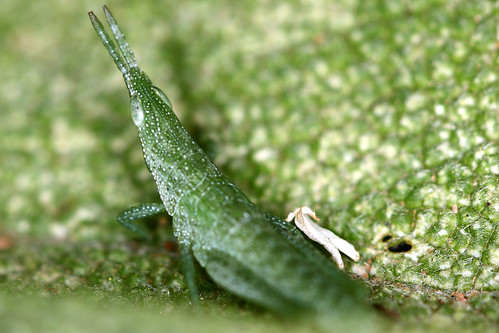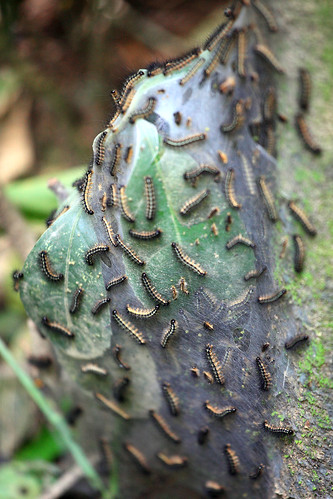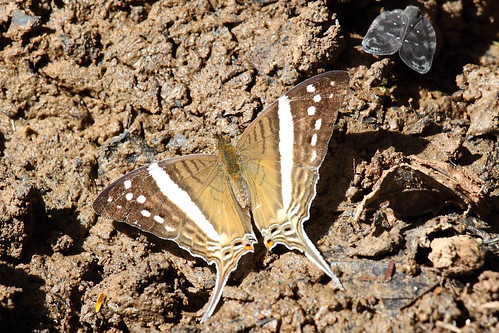

|
Archive
Blog
Cast
Forum
RSS
Books!
Poll Results
About
Search
Fan Art
Podcast
More Stuff
Random
Support on Patreon |
|
New comics Mon-Fri; reruns Sat-Sun
|
1 {photo of a grey-brown finch on a grey-brown background}
1 Caption: Camo
|
First (1) | Previous (3329) | Next (3331) || Latest Rerun (2581) |
Latest New (5175) First 5 | Previous 5 | Next 5 | Latest 5 Annotations theme: First | Previous | Next | Latest || First 5 | Previous 5 | Next 5 | Latest 5 This strip's permanent URL: http://www.irregularwebcomic.net/3330.html
Annotations off: turn on
Annotations on: turn off
|
 Green grasshopper on a green leaf. |
Humans have invented various camouflage patterns to make themselves and their gear difficult to see, but nature was doing it long before humans even existed.
The general principles of camouflage are to use colours that blend in with the surrounding terrain or vegetation, and to visually modify or break up the shape of the object being camouflaged, to make it more difficult to recognise as an object of interest. To a human, an object of interest may be another human who is an enemy combatant, or a piece of military hardware. So these things need to be hidden from other humans. What do animals need to hide from? Predators.
The natural world is a hostile and dangerous place. When we take a walk in a forest or through the mountains, we feel tranquility and peacefulness. It's a nice getaway from our industrial and hectic artificial world. But we feel safe only because we are relatively big animals in the scheme of things, and most of the places we tend to go walking have long been cleared of any predators likely to attack a human.
This is not an absolute, though. There are natural places where it is more dangerous to venture, where you run a risk of encountering a bear, or a crocodile, or a big cat. Something to remind you that humans are, in fact, made of meat, and that without our bubble of civilisation around us we are vulnerable to attack from other living things.
Imagine, then, being some other animal. A caterpillar perhaps, or a small lizard, or a rabbit. The world around you is full of things that will gladly eat you, if only they can catch you. But to catch you, they first have to find you.[1] So to have a better chance to survive and prosper, it helps if you can hide from predators.
 Nest of caterpillars. |
But caterpillars are not all exactly the same colour - even caterpillars of the same species. Just like humans, they come in a variety of shades, depending mostly on the colours of their parents. The colouration is a property of the genes carried inside the caterpillar's cells. When male and female butterflies mate, their genes mix together and new combinations are carried by their offspring caterpillars. This means that members of the next generation of caterpillars can vary in colour, and that's just with the same parents. Across the species, each generation of caterpillars has a more or less broad range of possible colouration.
Another method of generating variety of features in offspring is in the process of mutation. A mutation occurs when the genes are subject to copying errors, instead of being copied faithfully, as they are mixed and distributed to offspring from their parents' reproductive cells. A mutation can produce a feature in an offspring that was not present in either of its parents, or even within the usual range of variation found across the species. If all the caterpillars of some species are different shades of green, a mutation might produce an orange caterpillar, for example. Mutations are important for two reasons: firstly they allow variation in the species to be even broader than the gene mixing of sexual reproduction; and secondly they allow variation to occur in asexual reproduction, such as the splitting of single-celled protozoa or bacteria.
Now, given a range of caterpillars of different shades of green (perhaps with an orange one thrown in), which ones are most likely to survive? All other things being equal, the survivors will tend to be the ones who can hide best from predators. This means the ones that best match the green colour of the plants they feed on. Outliers of contrasting shades of green (or orange) are more likely to be noticed by a hungry bird and eaten. And if you're eaten as a caterpillar, you never become a butterfly, and you never reproduce.
The result of this is that the next generation of caterpillars is weighted towards having parents who come from the subset of the current generation of caterpillars whose shade of green best matches the plants they live on. This ensures that each successive generation of caterpillars stays very close to the shade of green of the plants, despite the variation caused by genetic mixing and mutations. Genetics combined with the pressures of avoiding predation mean that the caterpillars are generally well camouflaged.
But what if one day a new plant species appears in the area, distributed by wind blown seeds from far away, for example? What if this new plant has lots of bright red flowers and these flowers are good food for the caterpillars? Some caterpillars might end up on these plants and try eating the flowers. They might thrive that way, except for one thing. Nearly all of them are green. A green caterpillar sitting on a red flower stands out like a sore thumb to a bird (birds generally have very good colour vision), and many of them will be eaten.
 Butterfly showing shape-disruptive colouring. |
Not only that, but the orange caterpillars will come in various shades, some yellower, some redder. The redder ones have an advantage over both green caterpillars and yellowish orange ones, since the flowers they eat are red. In a few generations, what began as a single orange caterpillar will become a majority of red caterpillars.
At this point there is still likely to be a population of green caterpillars living on the old plants with the red flowers. They have no pressure pushing them towards becoming red. In fact, they have pressure pushing them to stay green. We end up with two populations of caterpillars: green ones which survive best on the original plants, and red ones which survive best on the new flowering plants. For a while these two populations will still be able to interbreed, but the resulting mix of colours in the offspring (inherited from one red-caterpillar and one green-caterpillar parent butterflies) will be somewhat conspicuous no matter on which plant they are laid. So if you were a green caterpillar, you're more likely to leave more surviving offspring if you mate with another green-caterpillar butterfly, and similarly if you were a red caterpillar, you're more likely to leave more surviving offspring if you mate with another red-caterpillar butterfly.
The signals that butterflies use to select mates - colour patterning of the butterfly wings, or pheromone scents, for example, are also traits that can be inherited from parents. In this way, it becomes more and more likely that the green and red caterpillars will end up mating with butterflies who were the same colour caterpillar as themselves. Now, if some harmless mutation occurs in, say, the green caterpillar group, it is less likely to be copied over to the red caterpillar group. Over generations, mutations will build up which cause the red and green caterpillar populations to drift apart genetically.
 Cicada. Green because it is normally in trees. |
But this may not always be the case. Consider our caterpillars again. We have red and green populations, which are building up different sets of mutations as the generations pass. At some point, one of those mutations will occur in a gene related to reproduction. Let's say it happens in a green caterpillar. That caterpillar is only one mutation step away from its green cousins, so may still be able to reproduce with them. But it is many mutation steps away from any of the red caterpillars, and it's possible that the result is now so different that our green caterpillar cannot breed with any red caterpillars (once they become butterflies), even if it tried to. If this gene gets copied into future generations of green caterpillars, we eventually end up with the situation where our green caterpillars and red caterpillars cannot interbreed at all any more. This event, which occurs gradually over many generations, is called speciation, and it is the splitting of our original caterpillar species into two distinct species.
This can happen in a few hundred generations. Many caterpillars breed annually - some even have multiple generations per year - so generations go by quickly. It's highly possible, perhaps even likely, that there are new species of butterflies around now somewhere in the world which did not exist a few hundred years ago.
This process of natural genetic variation through gene mixing and mutation, followed by differential survival rates of offspring, leading to different populations of organisms, and then eventually to the generation of new species, is called evolution (more specifically, evolution by the process of natural selection). In a few hundred years, evolution can produce new species somewhat similar to existing species. Given the thousands of millions of years available to life over the history of the planet Earth, evolution has produced all of the diversity of life we see in the animal and plant kingdoms, as well as the fungi, bacteria, and other things less visible to us.
It's a grand thing to realise that you share some of the same genes as a caterpillar. Parts of the DNA in your body are identical to parts of the DNA of any caterpillar, and they perform the same biochemical functions in your bodies. And the reason is because those biochemical functions evolved once, hundreds of millions of years ago, and we inherited them - caterpillars and humans - from the same source. All living things on Earth, humans, caterpillars, pine trees, mushrooms, are cousins.
It's amazing, and it's wonderful and beautiful.
|
LEGO® is a registered trademark of the LEGO Group of companies,
which does not sponsor, authorise, or endorse this site. This material is presented in accordance with the LEGO® Fair Play Guidelines. |